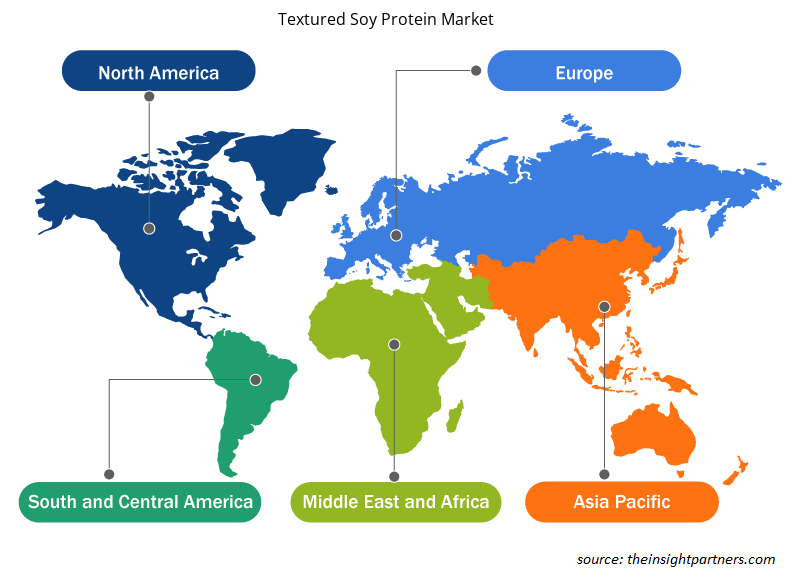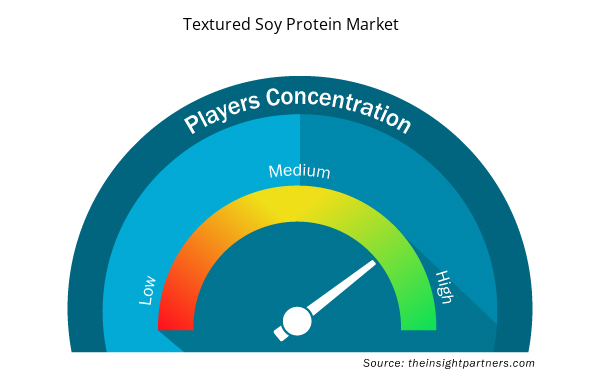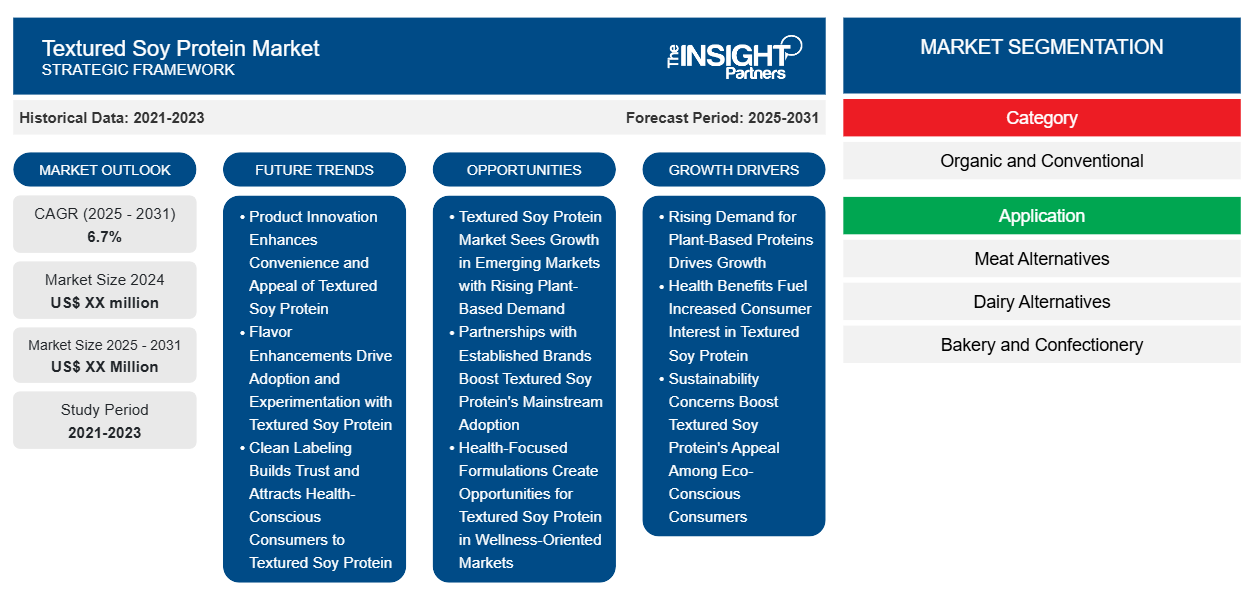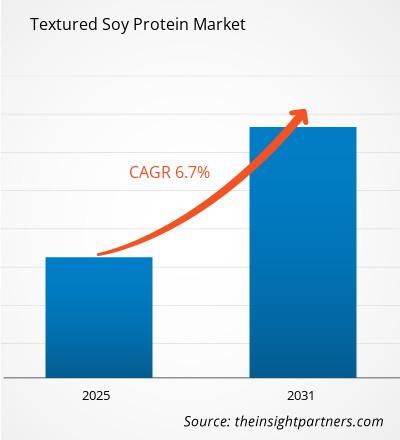Der Markt für texturiertes Sojaprotein wird voraussichtlich von 2024 bis 2031 eine durchschnittliche jährliche Wachstumsrate (CAGR) von 6,7 % verzeichnen, wobei die Marktgröße von XX Millionen US-Dollar im Jahr 2024 auf XX Millionen US-Dollar im Jahr 2031 wachsen wird.
Der Bericht ist nach Kategorien (biologisch und konventionell) segmentiert. Der Bericht enthält außerdem eine Analyse basierend auf der Anwendung (Fleischalternativen, Milchalternativen, Backwaren und Süßwaren, süße und herzhafte Snacks, Säuglingsnahrung und andere). Der Berichtsumfang umfasst fünf Regionen: Nordamerika, Europa, Asien-Pazifik, Naher Osten und Afrika sowie Süd- und Mittelamerika und Schlüsselländer in jeder Region. Die globale Analyse ist weiter auf regionaler Ebene und nach wichtigen Ländern aufgeschlüsselt. Der Bericht bietet den Wert in USD für die oben genannte Analyse und Segmente.
Zweck des Berichts
Der Bericht „Textured Soy Protein Market“ von The Insight Partners zielt darauf ab, die aktuelle Landschaft und das zukünftige Wachstum sowie die wichtigsten treibenden Faktoren, Herausforderungen und Chancen zu beschreiben. Dies wird verschiedenen Geschäftspartnern Einblicke geben, wie zum Beispiel:
- Technologieanbieter/-hersteller: Um die sich entwickelnde Marktdynamik zu verstehen und die potenziellen Wachstumschancen zu kennen, damit sie fundierte strategische Entscheidungen treffen können.
- Investoren: Durchführung einer umfassenden Trendanalyse hinsichtlich der Marktwachstumsrate, der finanziellen Marktprognosen und der Chancen entlang der Wertschöpfungskette.
- Regulierungsbehörden: Zur Regulierung von Richtlinien und Überwachungsaktivitäten auf dem Markt mit dem Ziel, Missbrauch zu minimieren, das Vertrauen der Anleger zu bewahren und die Integrität und Stabilität des Marktes aufrechtzuerhalten.
Marktsegmentierung für texturiertes Sojaprotein
Kategorie
- Bio und konventionell
Anwendung
- Fleischalternativen
- Milchalternativen
- Bäckerei und Konditorei
- Süße und herzhafte Snacks
- Säuglingsernährung
- Sonstiges
Passen Sie diesen Bericht Ihren Anforderungen an
Sie erhalten kostenlos individuelle Anpassungen an jedem Bericht, einschließlich Teilen dieses Berichts oder einer Analyse auf Länderebene, eines Excel-Datenpakets sowie tolle Angebote und Rabatte für Start-ups und Universitäten.
- Holen Sie sich die wichtigsten Markttrends aus diesem Bericht.Dieses KOSTENLOSE Beispiel umfasst eine Datenanalyse von Markttrends bis hin zu Schätzungen und Prognosen.
Wachstumstreiber auf dem Markt für texturiertes Sojaprotein
- Steigende Nachfrage nach pflanzlichen Proteinen treibt Wachstum an: Der Markt für texturiertes Sojaprotein wird stark durch die steigende Nachfrage nach pflanzlichen Proteinen angetrieben. Immer mehr Verbraucher ernähren sich vegetarisch und vegan und benötigen daher nährstoffangereicherte Fleischalternativen. Die angenehme Optik und Haptik, wie etwa die Fähigkeit, Fleischtexturen und -geschmack zu imitieren, ist einer der Hauptvorteile von texturiertem Sojaprotein.
- Gesundheitsvorteile steigern das Interesse der Verbraucher an texturiertem Sojaprotein: Der Markt für texturiertes Sojaprotein wächst, da sich die Verbraucher seines Nährwerts immer mehr bewusst werden. Texturiertes Sojaprotein ist reich an Proteinen, Ballaststoffen und essentiellen Aminosäuren und stärkt die Muskeln sowie das allgemeine Wohlbefinden. Da es fettarm ist und nützliche Nährstoffe enthält, wünschen sich gesundheitsbewusste Verbraucher mehr texturiertes Sojaprotein als Zusatz zu Mahlzeiten und Snacks.
- Nachhaltigkeitsbedenken steigern die Attraktivität von texturiertem Sojaprotein bei umweltbewussten Verbrauchern: Ein weiteres Anliegen, das den Markt für texturiertes Sojaprotein antreibt, sind Nachhaltigkeitsbedenken. Die Menschen entscheiden sich für viel umweltfreundlichere Lebensmittel und texturiertes Sojaprotein hat einen geringeren CO2-Fußabdruck und benötigt im Vergleich zu tierischen Proteinen weniger Ressourcen. Nachhaltigkeitsbedenken auf Verbraucherebene sind nicht umsonst, da das wachsende Interesse der Verbraucher an nachhaltiger Ernährung zu einer erhöhten Nachfrage nach texturiertem Sojaprotein führen wird, da umweltbewusste Verbraucher es mögen.
Zukünftige Trends auf dem Markt für texturiertes Sojaprotein
- Produktinnovationen verbessern die Benutzerfreundlichkeit und Attraktivität von texturiertem Sojaprotein: Produktinnovationen sind Veränderungen auf dem Markt für texturiertes Sojaprotein, und ein Akteur bringt verschiedene Angebote an Fertiggerichten, Snacks und Fleischersatz auf den Markt. Diese Innovationen gehen auf unterschiedliche Vorlieben ein und tragen auch zu den Ernährungsbedürfnissen der Verbraucher bei, verbessern die Benutzerfreundlichkeit und sprechen diejenigen an, die nach nahrhaften pflanzlichen Alternativen suchen, die dem modernen Lebensstil entsprechen.
- Geschmacksverbesserungen fördern die Akzeptanz und das Experimentieren mit texturiertem Sojaprotein: Geschmacksverbesserungen sind ein schnell aufkommender Trend bei texturiertem Sojaprotein. In dieser Kategorie experimentieren Marken mit kräftigen Gewürzen, Marinaden und Würzmitteln, um die leckersten und vielseitigsten Produkte auf dem Markt zu kreieren. Der Geschmack von texturiertem Sojaprotein macht es für Verbraucher sehr attraktiv, was zu einer größeren Akzeptanz und mehr Experimenten beim Kochen zu Hause führt.
- Clean Labeling schafft Vertrauen und zieht gesundheitsbewusste Verbraucher zu texturiertem Sojaprotein: Clean Labeling ist auf dem Markt für texturiertes Sojaprotein stark auf dem Vormarsch, da Verbraucher zunehmend transparentere Inhaltsstoffe verlangen. Produkte sollten aus erkennbaren, natürlichen Zutaten ohne künstliche Zusatzstoffe entwickelt werden. Dies fördert das Vertrauen der Verbraucher in Produkte und zieht gesundheitsbewusste und anspruchsvolle Verbraucher an, die nach einfachen und gesunden Nahrungsmitteln für ihre Ernährung suchen.
Marktchancen für texturiertes Sojaprotein
- Markt für texturiertes Sojaprotein wächst in Schwellenmärkten aufgrund steigender Nachfrage nach pflanzlichen Produkten: Wachsende Nachfrage nach pflanzlichen Proteinen beflügelt Markt für texturiertes Sojaprotein" Der Markt für texturiertes Sojaprotein hat in Schwellenmärkten, in denen pflanzliche Ernährung immer beliebter wird, ein enormes Wachstumspotenzial. Verbraucher mit steigendem verfügbaren Einkommen suchen nach gesünderen Nahrungsmitteln. Marken können ihre Produkte entsprechend der lokalen Kultur und Vorlieben gestalten, sie neuen Segmenten präsentieren und in einer kulturell vielfältigen Region Umsatzwachstum erzielen.
- Partnerschaften mit etablierten Marken fördern die allgemeine Akzeptanz von texturiertem Sojaprotein: Es gibt mehrere Möglichkeiten mit etablierten Lebensmittelmarken, aber für die Hersteller von texturiertem Sojaprotein wäre die Zusammenarbeit mit etablierten Marken-Lebensmittelunternehmen von Vorteil. Die etablierten Marken-Lebensmittelunternehmen werden sicherlich texturiertes Sojaprotein in beliebte Snackprodukte, Fertiggerichte oder Fleischersatzprodukte einarbeiten können, um ihre Sichtbarkeit und Glaubwürdigkeit zu erhöhen. Dies würde sicherlich Begeisterung für Verbraucherversuche wecken und texturiertes Sojaprotein zu einer Mainstream-Zutat mit Marktanteilen machen.
- Auf die Gesundheit ausgerichtete Rezepturen eröffnen Möglichkeiten für texturiertes Sojaprotein in Wellness-orientierten Märkten: Rezepturen mit Gesundheitsaspekten sind eine interessante Möglichkeit. Produkte könnten so formuliert werden, dass sie die spezifischen Vitamine, Mineralien oder funktionellen Inhaltsstoffe enthalten, nach denen gesundheitsbewusste Verbraucher suchen. Der Wellness-Fokus kann möglicherweise ein Differenzierungsmerkmal in einem wettbewerbsintensiven Markt sein und Zugang zu einer schnell wachsenden Nischengruppe verschaffen, die nach nahrhaften Lebensmitteln sucht.
Regionale Einblicke in den Markt für texturiertes Sojaprotein
Die regionalen Trends und Faktoren, die den Markt für texturiertes Sojaprotein im Prognosezeitraum beeinflussen, wurden von den Analysten von Insight Partners ausführlich erläutert. In diesem Abschnitt werden auch die Marktsegmente und die Geografie für texturiertes Sojaprotein in Nordamerika, Europa, im asiatisch-pazifischen Raum, im Nahen Osten und Afrika sowie in Süd- und Mittelamerika erörtert.

- Erhalten Sie regionalspezifische Daten zum Markt für texturiertes Sojaprotein
Umfang des Marktberichts über texturiertes Sojaprotein
| Berichtsattribut | Details |
|---|---|
| Marktgröße im Jahr 2024 | XX Millionen US-Dollar |
| Marktgröße bis 2031 | XX Millionen US-Dollar |
| Globale CAGR (2024 - 2031) | 6,7 % |
| Historische Daten | 2021-2023 |
| Prognosezeitraum | 2025–2031 |
| Abgedeckte Segmente | Nach Kategorie
|
| Abgedeckte Regionen und Länder | Nordamerika
|
| Marktführer und wichtige Unternehmensprofile |
|
Dichte der Marktteilnehmer für texturiertes Sojaprotein: Die Auswirkungen auf die Geschäftsdynamik verstehen
Der Markt für texturiertes Sojaprotein wächst rasant, angetrieben durch die steigende Nachfrage der Endverbraucher aufgrund von Faktoren wie sich entwickelnden Verbraucherpräferenzen, technologischen Fortschritten und einem größeren Bewusstsein für die Vorteile des Produkts. Mit steigender Nachfrage erweitern Unternehmen ihr Angebot, entwickeln Innovationen, um die Bedürfnisse der Verbraucher zu erfüllen, und nutzen neue Trends, was das Marktwachstum weiter ankurbelt.
Die Marktteilnehmerdichte bezieht sich auf die Verteilung von Firmen oder Unternehmen, die in einem bestimmten Markt oder einer bestimmten Branche tätig sind. Sie gibt an, wie viele Wettbewerber (Marktteilnehmer) in einem bestimmten Marktraum im Verhältnis zu seiner Größe oder seinem gesamten Marktwert präsent sind.
Die wichtigsten auf dem Markt für texturiertes Sojaprotein tätigen Unternehmen sind:
- Archer Daniels Midland Company
- Bremil-Gruppe
- Cargill, Incorporated.
- Crown Sojaprotein-Gruppe
- DuPont Ernährung und Gesundheit
Haftungsausschluss : Die oben aufgeführten Unternehmen sind nicht in einer bestimmten Reihenfolge aufgeführt.

- Überblick über die wichtigsten Akteure auf dem Markt für texturiertes Sojaprotein
Wichtige Verkaufsargumente
- Umfassende Abdeckung: Der Bericht deckt die Analyse von Produkten, Dienstleistungen, Typen und Endbenutzern des Marktes für texturiertes Sojaprotein umfassend ab und bietet einen ganzheitlichen Überblick.
- Expertenanalyse: Der Bericht basiert auf dem umfassenden Verständnis von Branchenexperten und Analysten.
- Aktuelle Informationen: Der Bericht stellt durch die Abdeckung aktueller Informationen und Datentrends Geschäftsrelevanz sicher.
- Anpassungsoptionen: Dieser Bericht kann angepasst werden, um den spezifischen Kundenanforderungen gerecht zu werden und die Geschäftsstrategien optimal anzupassen.
Der Forschungsbericht zum Markt für texturiertes Sojaprotein kann daher dabei helfen, die Branchensituation und Wachstumsaussichten zu entschlüsseln und zu verstehen. Obwohl es einige berechtigte Bedenken geben kann, überwiegen die allgemeinen Vorteile dieses Berichts tendenziell die Nachteile.
- Historische Analyse (2 Jahre), Basisjahr, Prognose (7 Jahre) mit CAGR
- PEST- und SWOT-Analyse
- Marktgröße Wert/Volumen – Global, Regional, Land
- Branche und Wettbewerbsumfeld
- Excel-Datensatz



Report Coverage
Revenue forecast, Company Analysis, Industry landscape, Growth factors, and Trends

Segment Covered
This text is related
to segments covered.

Regional Scope
North America, Europe, Asia Pacific, Middle East & Africa, South & Central America

Country Scope
This text is related
to country scope.
Häufig gestellte Fragen
Demand for transparency prompts brands to adopt clean-label practices in product formulations is expected to be the key market trend
The report can be delivered in PDF/Word format, we can also share excel data sheet based on request.
On the basis of geography, the textured soy protein market is classified into North America, Europe, Asia Pacific, Middle East and Africa, and South and Central America
The major factors driving the textured soy protein market are:
1. Increased interest in plant-based diets boosts demand for textured soy protein.
2. High in protein and essential amino acids, it appeals to health-conscious consumers.
Cargill Inc, DuPont, Sonic Biochem, Bremil Group, Archer-Daniels-Midland Co, CROWN SOYA PROTEIN GROUP, Kansas Protein Foods, Victoria Group, Sun Nutrafoods, Foodchem International Corp, and Merit Functional Foods
The Textured Soy Protein Market is estimated to witness a CAGR of 6.7% from 2023 to 2031
Trends and growth analysis reports related to Food and Beverages : READ MORE..
1. Archer Daniels Midland Company
2. Bremil Group
3. Cargill, Incorporated.
4. Crown Soya Protein Group
5. DuPont Nutrition and Health
6. Dutch Protein and Services B. V.
7. HungYang Foods, Co, Ltd
8. Shandong Yuxin Bio-Tech Co. , ltd.
9. Victoria Group A. D.
10. Wilmar International Ltd
The Insight Partners performs research in 4 major stages: Data Collection & Secondary Research, Primary Research, Data Analysis and Data Triangulation & Final Review.
- Data Collection and Secondary Research:
As a market research and consulting firm operating from a decade, we have published and advised several client across the globe. First step for any study will start with an assessment of currently available data and insights from existing reports. Further, historical and current market information is collected from Investor Presentations, Annual Reports, SEC Filings, etc., and other information related to company’s performance and market positioning are gathered from Paid Databases (Factiva, Hoovers, and Reuters) and various other publications available in public domain.
Several associations trade associates, technical forums, institutes, societies and organization are accessed to gain technical as well as market related insights through their publications such as research papers, blogs and press releases related to the studies are referred to get cues about the market. Further, white papers, journals, magazines, and other news articles published in last 3 years are scrutinized and analyzed to understand the current market trends.
- Primary Research:
The primarily interview analysis comprise of data obtained from industry participants interview and answers to survey questions gathered by in-house primary team.
For primary research, interviews are conducted with industry experts/CEOs/Marketing Managers/VPs/Subject Matter Experts from both demand and supply side to get a 360-degree view of the market. The primary team conducts several interviews based on the complexity of the markets to understand the various market trends and dynamics which makes research more credible and precise.
A typical research interview fulfils the following functions:
- Provides first-hand information on the market size, market trends, growth trends, competitive landscape, and outlook
- Validates and strengthens in-house secondary research findings
- Develops the analysis team’s expertise and market understanding
Primary research involves email interactions and telephone interviews for each market, category, segment, and sub-segment across geographies. The participants who typically take part in such a process include, but are not limited to:
- Industry participants: VPs, business development managers, market intelligence managers and national sales managers
- Outside experts: Valuation experts, research analysts and key opinion leaders specializing in the electronics and semiconductor industry.
Below is the breakup of our primary respondents by company, designation, and region:

Once we receive the confirmation from primary research sources or primary respondents, we finalize the base year market estimation and forecast the data as per the macroeconomic and microeconomic factors assessed during data collection.
- Data Analysis:
Once data is validated through both secondary as well as primary respondents, we finalize the market estimations by hypothesis formulation and factor analysis at regional and country level.
- Macro-Economic Factor Analysis:
We analyse macroeconomic indicators such the gross domestic product (GDP), increase in the demand for goods and services across industries, technological advancement, regional economic growth, governmental policies, the influence of COVID-19, PEST analysis, and other aspects. This analysis aids in setting benchmarks for various nations/regions and approximating market splits. Additionally, the general trend of the aforementioned components aid in determining the market's development possibilities.
- Country Level Data:
Various factors that are especially aligned to the country are taken into account to determine the market size for a certain area and country, including the presence of vendors, such as headquarters and offices, the country's GDP, demand patterns, and industry growth. To comprehend the market dynamics for the nation, a number of growth variables, inhibitors, application areas, and current market trends are researched. The aforementioned elements aid in determining the country's overall market's growth potential.
- Company Profile:
The “Table of Contents” is formulated by listing and analyzing more than 25 - 30 companies operating in the market ecosystem across geographies. However, we profile only 10 companies as a standard practice in our syndicate reports. These 10 companies comprise leading, emerging, and regional players. Nonetheless, our analysis is not restricted to the 10 listed companies, we also analyze other companies present in the market to develop a holistic view and understand the prevailing trends. The “Company Profiles” section in the report covers key facts, business description, products & services, financial information, SWOT analysis, and key developments. The financial information presented is extracted from the annual reports and official documents of the publicly listed companies. Upon collecting the information for the sections of respective companies, we verify them via various primary sources and then compile the data in respective company profiles. The company level information helps us in deriving the base number as well as in forecasting the market size.
- Developing Base Number:
Aggregation of sales statistics (2020-2022) and macro-economic factor, and other secondary and primary research insights are utilized to arrive at base number and related market shares for 2022. The data gaps are identified in this step and relevant market data is analyzed, collected from paid primary interviews or databases. On finalizing the base year market size, forecasts are developed on the basis of macro-economic, industry and market growth factors and company level analysis.
- Data Triangulation and Final Review:
The market findings and base year market size calculations are validated from supply as well as demand side. Demand side validations are based on macro-economic factor analysis and benchmarks for respective regions and countries. In case of supply side validations, revenues of major companies are estimated (in case not available) based on industry benchmark, approximate number of employees, product portfolio, and primary interviews revenues are gathered. Further revenue from target product/service segment is assessed to avoid overshooting of market statistics. In case of heavy deviations between supply and demand side values, all thes steps are repeated to achieve synchronization.
We follow an iterative model, wherein we share our research findings with Subject Matter Experts (SME’s) and Key Opinion Leaders (KOLs) until consensus view of the market is not formulated – this model negates any drastic deviation in the opinions of experts. Only validated and universally acceptable research findings are quoted in our reports.
We have important check points that we use to validate our research findings – which we call – data triangulation, where we validate the information, we generate from secondary sources with primary interviews and then we re-validate with our internal data bases and Subject matter experts. This comprehensive model enables us to deliver high quality, reliable data in shortest possible time.


 Holen Sie sich ein kostenloses Muster für diesen Bericht
Holen Sie sich ein kostenloses Muster für diesen Bericht